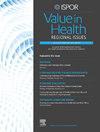Lifetime Cost-Effectiveness of Using the Chinese Diabetes Risk Score for Prediabetes Screening in China
IF 1.4
Q3 HEALTH CARE SCIENCES & SERVICES
引用次数: 0
Abstract
Objectives
To more comprehensively evaluate the lifetime cost-effectiveness of different prediabetes screening strategies based on the Chinese Diabetes Risk Score (CDRS) from a societal perspective and to explore the impact of different CDRS cutoff values on the evaluation.
Methods
A Markov model encompassing the complete natural history of type 2 diabetes was developed to compare costs, cumulative prevalence of type 2 diabetes complications, mortality rates, and quality-adjusted life years of 3 screening strategies: (1) the control group, the current screening strategy; (2) strategy 1, CDRS screening for all adults; and (3) strategy 2, supplemental CDRS screening for adults without annual health checkups. It was assumed that the individual exited the model upon reaching 80 years old or death in the model. The robustness of results was assessed through sensitivity analyses.
Results
Compared with the control group and strategy 2, strategy 1 saved $583.07 and $233.12 per capita, respectively, reduced the cumulative prevalence of type 2 diabetes complications by 8.47% and 1.64%, respectively, reduced mortality rates by 1.47% and 0.25%, respectively, and increased quality-adjusted life years by 0.07 and 0.01 per capita, respectively. At the cutoff value of 24, strategy 1 achieved the lowest cost and the highest health benefits.
Conclusions
Compared with the control group and strategy 2, strategy 1—implementing prediabetes screening in all adults via CDRS—was absolutely dominant when modeling the complete natural history of diabetes. The CDRS screening strategies demonstrated better cost-effectiveness when the cutoff value was set at 24.
中国糖尿病风险评分用于糖尿病前期筛查的终生成本-效果
目的从社会角度更全面地评价基于中国糖尿病风险评分(CDRS)的不同前驱糖尿病筛查策略的终生成本-效果,并探讨不同CDRS临界值对评估的影响。方法建立包含2型糖尿病完整自然史的马尔可夫模型,比较3种筛查策略的成本、2型糖尿病并发症累积患病率、死亡率和质量调整生命年:(1)对照组,当前筛查策略;(2)策略一,对所有成人进行CDRS筛查;(3)策略2,对未进行年度健康检查的成年人进行CDRS补充筛查。假设个体在达到80岁或在模型中死亡时退出模型。通过敏感性分析评估结果的稳健性。结果与对照组和策略2相比,策略1人均分别节省583.07美元和233.12美元,2型糖尿病并发症累计患病率分别降低8.47%和1.64%,死亡率分别降低1.47%和0.25%,人均质量调整生命年分别增加0.07年和0.01年。在临界值为24时,策略1实现了最低的成本和最高的健康效益。结论与对照组和策略2相比,策略1——通过cdrs对所有成年人进行糖尿病前期筛查——在模拟糖尿病的完整自然史时占绝对优势。当临界值设置为24时,CDRS筛选策略显示出更好的成本效益。
本文章由计算机程序翻译,如有差异,请以英文原文为准。
求助全文
约1分钟内获得全文
求助全文
来源期刊

Value in health regional issues
Pharmacology, Toxicology and Pharmaceutics-Pharmacology, Toxicology and Pharmaceutics (miscellaneous)
CiteScore
2.60
自引率
5.00%
发文量
127
 求助内容:
求助内容: 应助结果提醒方式:
应助结果提醒方式:


